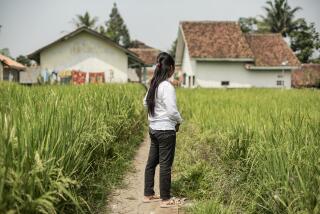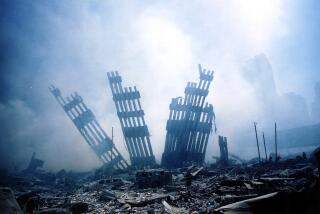Behind the story: From Nepal to Saudi Arabia, reporting how a dead man came back to life
KATMANDU, Nepal — I had been living in Katmandu, Nepal’s capital, for only a few weeks — still adjusting to the predawn bell-ringing, the dusty film over everything, the dozing street dogs and post-earthquake scaffolding — when a short headline buried in an English-language newspaper caught my eye:
“Dead Man Comes Back to Kathmandu.”
My partner and I moved to Nepal in May 2017, two years after the devastating magnitude 7.8 earthquake. He was an engineer, helping reconstruct the crumbled temples. I was a freelance writer hoping to cover one of the largest human migrations on the planet, though it gets scant attention in American media: laborers leaving South Asia for the Persian Gulf states, sponsored by some of the world’s biggest corporations.
One such laborer was Subash Tamang, who was mistakenly declared dead after a traffic accident in Saudi Arabia.
I’d hit a wall in my efforts to find him, when a few weeks later, over momos, Nepal’s ubiquitous dumplings, and the sounds of a Nepali-Afro-funk-jazz band, a friend introduced me to a University of Pennsylvania law student interning at the Center for Migration and International Relations. The Katmandu-based nonprofit helped migrant workers, and I told him about the haunting headline — and he told me the organization was helping Subash’s family.
The story was even stranger and darker than I’d imagined, and it wouldn’t leave me alone for the next 3½ years.
The story followed me from Nepal to Saudi Arabia and back, to stints in West Africa and Eastern Europe, and all the way to Washington, D.C.
It followed me to a few different magazines. The editor of one publication that bought the story ultimately decided not to use it, telling me: “My ideal story is: ‘Instagram has a Facebook problem.’”
So it followed me to the Los Angeles Times.
The story, which revealed disturbing truths about the lives of migrant workers in Saudi Arabia, was made possible by people who sometimes took risks — physical as well as political — to talk to me.
In Nepal, which has one of the world’s worst aviation safety records, I took a tiny plane to a regional capital and drove a few hours to Subash’s small town of Laxmimarga, near the Indian border. The smog choking Katmandu Valley had kept me from my first glimpse of the Himalayas. Now peaks punched through the clouds out the plane window. The snow-covered crags made a sharp contrast with the impossible green of the rice paddies below.
I interviewed Subash as he sat on his front porch, holding his death certificate from Saudi Arabia, laughing and crying at the same time.
The death certificate should have carried the name of another young Nepali man, Tejendra Bhandari. Saudi officials and Subash’s sponsor, Hyundai Heavy Industries, had misidentified Tejendra’s body after the 2015 taxi crash in Jidda, setting off a chain of events that still plagues both men’s families.
Getting to Tejendra’s family in the Himalayan foothills was harder. Several drivers said the drive to the village, 12 hours by car from the closest airport during good weather, was impossible during the rainy season. One — for a hefty fee, of course — said he’d try.
At the end of the brain-jiggling journey, the bridge out of the last town was washed out, he informed us. We’d have to hike the last four hours, likely in the dark.
When we emerged from a sheet of rain at a small rest stop along the mountain road, the owner was stunned. Dripping wet and foggy-headed with the altitude of what Nepalis refer to as mere hills, I thought there was no way Tejendra’s sister, Him Kumari, with rare access to one cellphone shared between a dozen relatives, would ever find us.
But not too long after, she appeared from the downpour. We followed her swift, silent walk along muddy trails that sucked your shoes off your feet. A roaring came from the distant black, somewhere below. In daylight, we saw what a misstep would’ve meant.
At their cement-floored home, Tejendra’s family had stayed up for our late arrival. It was the first time they’d ever met “foreigners,” Him Kumari explained. Over the fire, she told us that she raised Tejendra, her only sibling. When she refused to carry him anymore, he’d throw pebbles at her until she picked him up, she smiled, shaking her head.
Tejendra’s death had left them with thousands of dollars of debt they took on to get his job in Jidda, but no way to pay it off. They fed us lentils cooked in onion and garlic and thin milk from the water buffalo that lowed outside. We were the only ones who ate, but it would’ve been disrespectful to refuse.
A younger relative offered us raksi, Nepalese moonshine, and, by flashlight, told us he was thinking of leaving Nepal for work, too, despite Tejendra’s death.
“Nobody wants to go abroad,” he said. “We have to.”
“You are treated like a slave,” a sister-in-law said. “But whatever they do to you, you have to bear it.”
The next day, Subitra, Tejendra’s mother, in her 70s, insisted on leading us back to the main trail, donning bright-blue wellies and a walking stick. She wanted to guide us the four hours down to the next town, but we eventually persuaded her to turn back.
Getting a visa to report in Saudi Arabia was a bigger challenge. I applied from Nepal, Morocco and Spain, bombarding any Saudi bureaucrat contact I could find. One day, from a cafe in Morocco, I interviewed Jamal Khashoggi, a well-known Saudi expert who maintained ties to the royal family despite having recently gone into exile in Virginia.
He said that migrant labor was something of a pet issue of his — he’d once written a book warning that if the Saudi government didn’t lessen its dependence on foreign workers, it’d have its own Arab Spring.
“If Nepali workers demonstrate and burn tires, Saudi Arabia will deport them,” he told me. “When the Saudis do that, what is our government going to do? Those millions of young Saudis who want jobs, eventually they might go on the streets.”
He said he’d recently asked the crown prince, Mohammed bin Salman, about migrant labor. Even as Mohammed promoted “Vision 2030,” his economic plan intended to wean the country off oil subsidies and foreign workers, Khashoggi said, “he sees the position of Saudi Arabia — near the subcontinent, close to cheap foreign labor — as a competitive advantage.”
I mentioned I’d been trying to get a visa to report in Saudi Arabia, and he gave me a Saudi official’s name, adding: Don’t tell them it came from me.
Shortly after, I was told my visa had been approved. (A year later in Istanbul, Turkey, I was shocked, like much of the world, to learn Khashoggi had been killed in the Saudi Consulate there.)
I was in Spain when I finally booked my ticket for Saudi Arabia. At the recommendation of women journalist colleagues, I scoured Madrid for an abaya, the customary all-black dress for women in Saudi Arabia. Failing to find one, I bought the most conservative items I could.
When I stepped off the plane in Riyadh, my Saudi government handler took one look at me and said: “Oh, you have dressed Turkish-style.” He made clear it was something of an insult. The next day at the hotel, an abaya was waiting for me. It was too long; I kept tripping.
In Riyadh and Jidda, I worked with Indian drivers who spoke English, Arabic and Hindi to interview dozens of Nepalese and other South Asian workers. Amid a collapse in oil prices at the time, thousands of migrant workers had been stranded, unpaid and unable to go home. They staged rare protests, and we spoke to some outside a labor camp for Saudi Binladen Group, the construction giant whose owning family had disowned their son, Osama. The company had laid off thousands of foreign laborers.
Feeling awkward sitting in the back of an SUV for hours in endless traffic, I moved up front. On one trip, as we approached a security checkpoint, I realized belatedly how vulnerable the driver was as a foreign worker in Saudi Arabia — and the danger I had put him in. Because we were not related or married, he explained, I wasn’t supposed to be sitting up front with him. The officer waved us through, and the driver’s grip on the steering wheel loosened.
After a week and several attempts to visit the power plant where Subash had worked, the government handler said Hyundai and Saudi officials declined to meet me or let me see the plant, in part because I was a single woman.
Officials also evaded interviews back in Nepal. One official’s secretary told me he wouldn’t be coming because he was in the hospital; he walked in a few minutes later. Another, when I asked about the thousands of Nepalese worker deaths documented in Saudi Arabia and the legal violations I’d seen — including a dozen Nepalis who’d worked for a year without pay and were forced to sleep outside their own consulate in Jidda in 100-degree heat — exploded that I was trying to impose my “Western values.”
Now, some 25,000 Nepalese workers are again stranded abroad, and even more are struggling back home amid the coronavirus and global economic collapse.
This is what haunted me about Subash and Tejendra’s story, and haunts their families still — that dignity would be denied them even in death. They’re surprised I’ve stuck with it, as if to ask: Does anyone care how they live and die?
More to Read
Sign up for Essential California
The most important California stories and recommendations in your inbox every morning.
You may occasionally receive promotional content from the Los Angeles Times.









